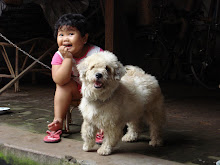This paper focuses the analysis on style and register found in the data. Holmes says that people’s speech style is influenced by many factors, such as age, gender, social roles, and occupation (p. 236). According to Trudgill (1992) styles are seen “as varieties of language viewed from the point of view of formality". For example, a secretary uses formal style when talking to her boss. She should show her respect because her boss has higher status. However, she uses casual style to her best friend in that office when sharing about her personal problem. It is done to minimize distance.
In this data, it is found that the respondents use informal speech style. They use informal Indonesian, such as in :
LL : Mau dagang apa emang si Wiwit ?
[What does Wiwit wanna sell actually?]
LL and LKH are related. LKH is LL’s aunt. Therefore, LL says “Mau dagang apa emang si Wiwit ? which is the informal style of “Mau berdagang apakah Wiwit ?
They also use Betawi language which is classified as vernacular.
LKH :Bener. Ya udah, ambil itu aje gelas aqua.
[Right. Take that Aqua glass.]
JM :Iya. Itu juga mungutin gelas aqua. Saya ngumpulin. (laughing)
[Yes. I pick it up, too. I collect it.] (laughing)
LKH says “aje” instead of saja. JM says mungutin instead of memungut and ngumpulin instead of mengumpulkan. The ending –in is commonly used in Betawi language. There are some Betawi particles, such as: deh and sih.
They use some Javanese words.
LKH : Si embak - embak dagang yang di pinggir jalan kereta tuh kan deket tukang
buah. Tanya deh alamatnya.
The girl selling near the railway, near the fruit-seller over there. Why
don’t you ask her address?
LKH uses the words “embak-embak” (a young lady) which is taken from Javanese “mbak” (sister).
The reasons why the respondents choose informal style can be summarized as follows:
1.Two of the respondents (LKH and JM) are neighbors. Informal style is used to show that they have known each other and to minimize the social distance.
2.Two of the respondents (LKH and LL) are part of the same family. Informal style is commonly used among family members.
3.Two of the respondents (LKH and JM) have similar educational background.
4.The setting is at the grocery store. In this place formal style is not required.
Holmes describes register as the use of specific words used for a particular occupational group (p.259). Two of the respondents in this data are in the same line of business. Both are sellers. They share the same knowledge of buying and selling business. It can be seen from the specific vocabulary they use when talking about their business, such as: utang piutang (loan), modal (capital), kios (kiosk), dagangan (merchandise), laku (sold out), kaki lima (street vendor).
Tuesday, March 2, 2010
SOCIOLINGUISTICS PROJECT
Posted by TEFL TERE at 4:18 AM
Subscribe to:
Post Comments (Atom)

No comments:
Post a Comment